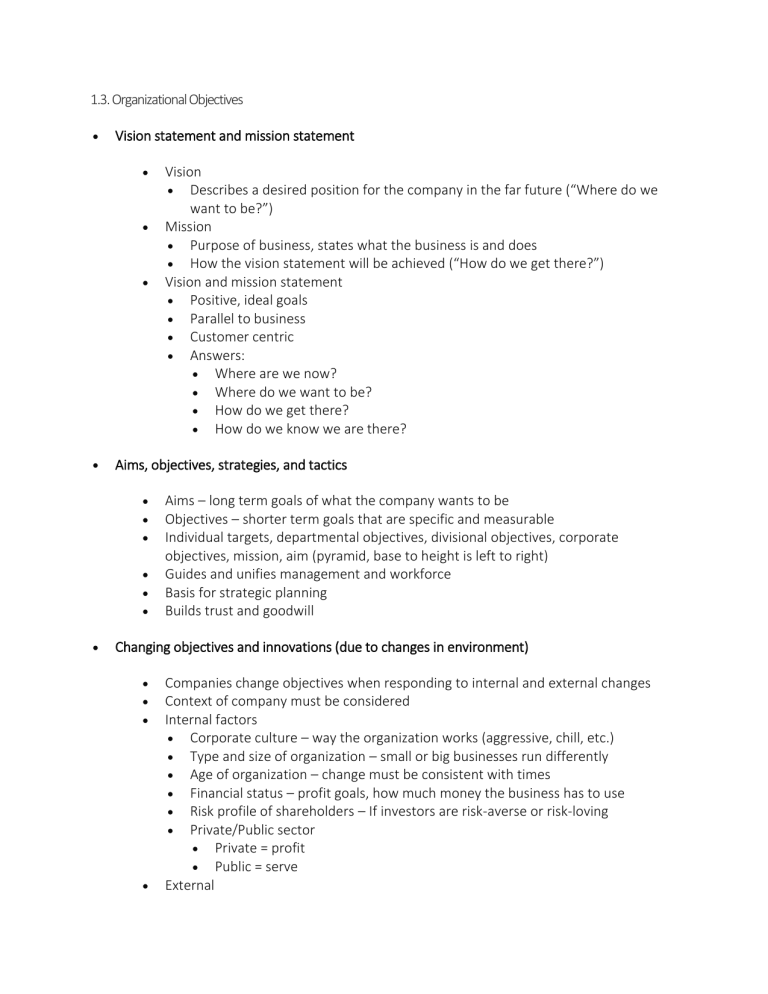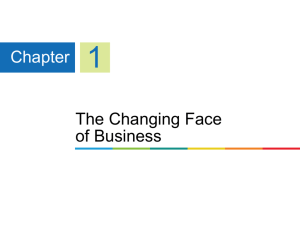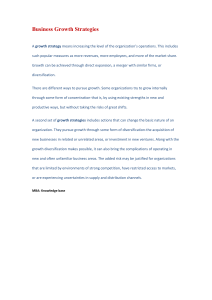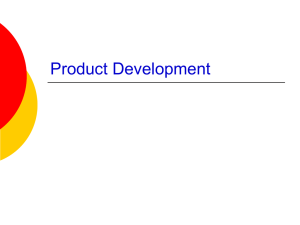
1.3. Organizational Objectives Vision statement and mission statement Aims, objectives, strategies, and tactics Vision Describes a desired position for the company in the far future (“Where do we want to be?”) Mission Purpose of business, states what the business is and does How the vision statement will be achieved (“How do we get there?”) Vision and mission statement Positive, ideal goals Parallel to business Customer centric Answers: Where are we now? Where do we want to be? How do we get there? How do we know we are there? Aims – long term goals of what the company wants to be Objectives – shorter term goals that are specific and measurable Individual targets, departmental objectives, divisional objectives, corporate objectives, mission, aim (pyramid, base to height is left to right) Guides and unifies management and workforce Basis for strategic planning Builds trust and goodwill Changing objectives and innovations (due to changes in environment) Companies change objectives when responding to internal and external changes Context of company must be considered Internal factors Corporate culture – way the organization works (aggressive, chill, etc.) Type and size of organization – small or big businesses run differently Age of organization – change must be consistent with times Financial status – profit goals, how much money the business has to use Risk profile of shareholders – If investors are risk-averse or risk-loving Private/Public sector Private = profit Public = serve External Corporate social responsibility (CSR) State of economy – strong or depressed economy affects the company too Government constraints – government telling you not to expand somewhere Presence and power of pressure groups – (e.g. not to expand in the endangered locations) Concept whereby organizations consider the interests of society by taking responsibility for the impact of their activities on various stakeholders Benefits: Better employee recruitment and retention Sense of value/purpose for employees Boosts company’s image/reputation Risk management against scandals, accidents, etc. Appeases pressure groups Brand differentiation and smoother operations Customer loyalty & goodwill Disincentives: High compliance costs can lower profits Forced to use materials that are specialized and may reduce profit Ethics are not universal or unchanging anyway Lower profits may decrease personal bonuses which may lead to greediness Attitudes change over time; acceptable practices before are unacceptable today. CSR objectives adapt to changes in social norms/hot issues (i.e. tattoos, dyed hair, jeans, single parents, gender bias, child labor, smoking, obesity, global warming, etc.) SWOT analysis Qualitative form of assessment Guides management for future strategies Used alongside STEEPLE, which helps to further identify opportunities and threats Internal factors Strengths – advantages that are basis for developing competitive advantage. e.g. experienced management, patents, loyal workforce/customers Weakness – negative factors e.g. poorly trained workforce, limited capacity, obsolete equipment, etc. External factors Opportunities – potential areas for expansion of the business and future profits e.g. political/economical policies, social statistics & trends, etc. Threats – hindrances to the business e.g. economic environment, market condition competitors. Ansoff Matrix Analytic tool to determine growth strategy by focusing on product/market combination Growth strategies Existing product + existing market = Market Penetration (low risk) Seeks to maintain or increase market share Price adjustments Increase of market promotion Minor product improvements Intense competition New product + existing market = Product Development (medium risk) Innovation to replace existing products Focusing on consumer needs Brand extension Capitalize on technology Consumers in existing market may not like the new product Existing product + new market = Market Development (medium risk) New distribution channel Expanding geographically Attract new market segments New consumers may not like the product New product + new market = Diversification (high risk) If successful, higher gains can be reaped from various industries Spreads out risks and safeguards against economic shocks over diverse product portfolio Related diversification (same industry – e.g. McDonalds and McCafe) Unrelated diversification (different industry – e.g. Zesto and Zest Air)



